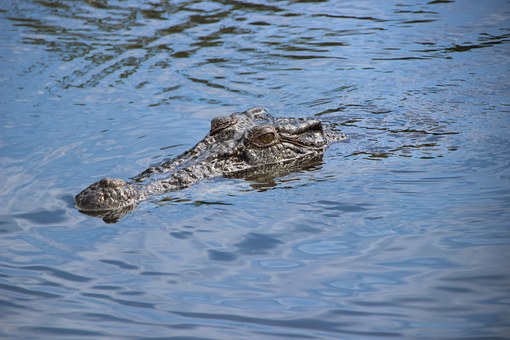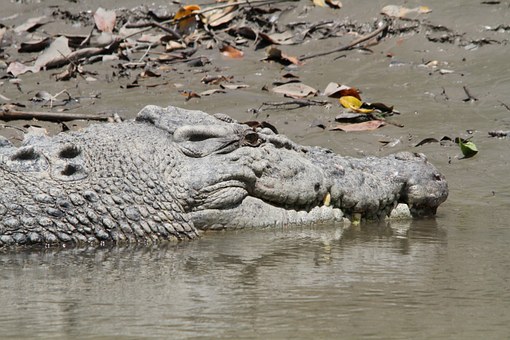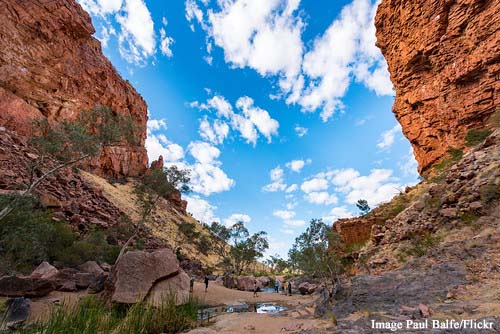|
Northern Territory Home - Alice Springs Guide - Ayers Rock Guide - Darwin Guide
Amazing
Alice
- The
West Macdonnell Ranges
8
Ways Not to Get Eaten by a Crocodile in the Northern Territory
Want to see crocodiles in their
natural habitat, but do not want to get eaten? Saltwater crocodiles are
the world's largest reptile. An average length and weight of the males
is five metres(15 feet)and 450 kilos. Females are smaller, about three
metres in length and weigh up to 150 kilos. For tips on staying safe from
crocodiles, read further.
1. KEEP OUT
OF THE WATER.
Staying away from the waterways,
lagoons, billabongs and creeks is the best way to ensure that you will
never get eaten by a saltwater crocodile. However, this is not really
the answer that people want to hear. But if you are in crocodile country
stay at least five metres away from the water. Although on land they can
produce a sudden burst of speed to catch unwary prey. You will not get
away.

2. TAKE HEED
OF THE 'BEWARE OF CROCODILE' SIGNS
The National Park Rangers
have placed these signs up where there are known crocodile sightings.
If there is no sign at a waterhole, it does not mean that there will not
be a crocodile. The saltwater crocodile can walk and swim long distances
overland and along waterways, mainly through the wet season. Crocodiles
can and do spend most of their lives in fresh water after swimming hundreds
of kilometres inland.
3. TALK TO
THE LOCALS
The locals have insight and
knowledge of the crocodile habits in the areas. These people are the ones
who have seen crocodiles in their local area and have a good idea of their
sizes. Unfortunately, some of the locals have become blasé about
the 'safe' swimming holes, and a few have come to grief.
Since 1971, there has been
no culling of crocodiles in the Northern Territory, and in the last 40
years, saltwater crocodiles have increased from 5,000 to 75,000 in numbers.
Saltwater crocodiles are coming into fresh waterways in the wet seasons,
often travelling long distances overland, where they have never been before
when these adults were children.
4. FISH IN
A BIGGER BOAT
Go out fishing in a boat
bigger than any known large sized crocodile in the area. Crocodiles have
attacked small fishing boats and can easily overturn them, with the
fisherman in it.

5. FISH WITH
AN EXPERIENCED TOUR OPERATOR
Preferably go out fishing
with an experienced fishing charter captain. There are always fishing charters
available and these boats are large and safe.
6. NEVER TORMENT
OR TEASE A CROCODILE
It is extremely dangerous
to throw sticks or stones at a crocodile. This will make them angry enough
to come after you. The crocodile may look like it is sunning itself quietly
on the riverbank, and to be asleep. However, when it moves, it will
be surprisingly fast. Keep well away from it.
7. NEVER KEEP VISITING
THE SAME SPOT
Crocodiles are a creature
of habit and will watch to see if you are, too. They will watch you for
a few days or more, biding their time to attack. If you camp by the waterside,
do so at your own peril. They have been known to drag a man out of a tent
during the night.
8. NEVER LET
YOUR DOG SWIM IN THE WATER
Always keep your dog out
of the water as crocodiles are quick to move in for the kill. The dog's
barking on the riverbank will attract crocodiles very fast. Dogs have as
little chance of escape as people do against a hungry or territorial crocodile.
If you abide by these suggestions,
and always use commonsense, your holiday visit to Darwin or any other coastal
parts of the Northern Territory in Australia will be quite safe and very
enjoyable. There are several really good water leisure centres for safe
swimming and excellent crocodile farms and parks to view crocodiles.
Top
Patricia Lilly holds a Diploma
of Hospitality and has experience in tourism. Online Accommodation and
Tours-Australia is the business she has developed using her extensive experience
and knowledge. Patricia ensures safe and secure accommodation bookings
for your next holiday.
The
West Macdonnell Ranges by Gavin Wyatt
For most people mention of
Alice Springs stirs up images of expansive and dusty red space, stark desert
landscapes that are harshly beautiful, simmering under the hot sun that
beats down onto the centre of Australia. Ayers Rock is probably the most
popular option for campervan tourists coming to this region, but an alternative
that is closer to Alice and every bit as rewarding for a self drive excursion
is the West Macdonnell National Park. A round trip that takes in all the
main attractions here is about 300 kilometres in length, and will take
you through semi-desert country that is home to impressive gorges, rugged
mountains and peaceful natural swimming holes. So for the ultimate experience
of the 'red centre' of Australia pick up your camper in Alice and strike
out west to experience the West Macdonnell Ranges.

For an educational insight
into the flora, fauna and natural features of the area stop in at the Alice
Springs Desert Park, which is just outside of the city. Perfect for kids,
and just as interesting for adults, expect to leave here armed with some
knowledge about the amazing landscape you are about to drive through. Not
far from here you reach the first selling point of the Ranges, Simpsons
Gap, which is a natural waterhole lined with ghost gums and surrounded
by high cliffs.
Swimming is not permitted
here, but you can lounge on the banks and enjoy watching the black footed
rock wallabies bound amongst the rocks. There are a couple of designated
walking trails here, and you can make use of the free barbeque sites as
well.
Continuing along Larapinta
Drive for about twenty two kilometres brings you to the turn off to Standley
Chasm, which is a further nine kilometres in from that point. this rock
cleft is just a few metres wide, but towers to over eighty metres in height.
At midday the overhead sun bounces off the walls with a strong orange reflection,
so try and time your visit to fit in with this amazing spectacle. There
is an entry fee here, and the chasm is open from 8 am to 6 pm. A kiosk
operates in these times, offering basic food and drink supplies to visitors.

Just past Standley the road
splits into two, and you should branch right onto the Namatjira Drive.
Forty two kilometres on from where the road parts and you reach Ellery
Creek Big hole, a deep and permanent swimming hole with the reputation
of being the coldest pool in the region. The sandy creek here is lined
with tall gums, which in turn are towered over by the characteristic red
cliffs of the region. The permanence of the waterhole means it is relied
upon by plenty of flora and fauna as a source of water, so you are likely
to see an array of local animals bounding amongst the rocks and vegetation.
Eleven kilometres further
up Namatjira Drive is Serpentine Gorge, which is unique in that there is
a large billabong which is only accessible by swimming up the gorge. The
area is secluded and there are some stunning walking trails, with one in
particular providing a stunning view of the ranges. Drive on from this
gorge for twelve kilometres and you'll find the Ochre Pits, which is where
the local aboriginal people used to glean their ochre pigments from. Ochre
is of significant importance as body paint and in traditional ceremonies,
and therefore this area is very culturally significant to the local indigenous
population. The pits consist of several layers of multi coloured and multi
layered rock, and is worth a visit for its natural beauty and its cultural
heritage.

The most inspiring gorge
in the Ranges is the Ormiston Gorge and Pound. Over 300 metres deep in
some spots, the wide deep pool here rests at the base of tall red cliffs
which offer an abundance of viewing points and walking trails. There are
official picnic spots and unpowered camping spots, so park your campervan
and enjoy the quiet of the gorge at night.
A bit further on is Glen
Helen Gorge, which is your penultimate destination and where most people
chose to bunk down for a few nights because of the good camping facilities
and the motel style accommodation on offer. There is also the chance to
go on guided hikes and even helicopter tours of the region. Its the perfect
place to base yourself for a few days and explore your surrounds, or you
could turn around and start heading back slowly and take in everything
you have missed on the way here!
Top
|

